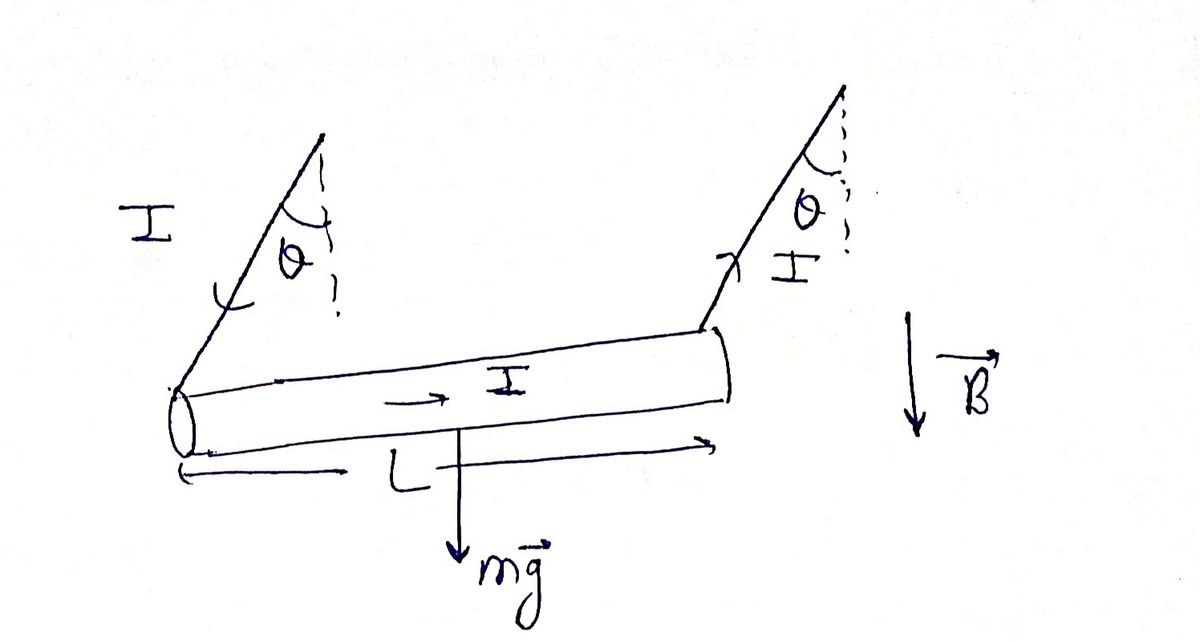College Physics
11th Edition
ISBN:9781305952300
Author:Raymond A. Serway, Chris Vuille
Publisher:Raymond A. Serway, Chris Vuille
Chapter1: Units, Trigonometry. And Vectors
Section: Chapter Questions
Problem 1CQ: Estimate the order of magnitude of the length, in meters, of each of the following; (a) a mouse, (b)...
Related questions
Question
A horizontal metal bar of mass mmm and length L is vertically suspended from two
Find the angle θ the suspending wires make with the vertical when the bar carries a current I.
Express your answer in terms of the variables m, L, B, I, and appropriate constants.

Transcribed Image Text:The image illustrates a metal rod positioned within a magnetic field. Here's the breakdown of the diagram's components:
- **Rod:** The rod is oriented horizontally and is labeled with length \(L\).
- **Current (\(I\)):** The rod carries a current denoted as \(I\) flowing through it.
- **Angles (\(\theta\)):** The current carrying wires form angles \(\theta\) with the horizontal both on the left and right sides of the rod.
- **Magnetic Field (\(\vec{B}\)):** A magnetic field is represented by a vertical blue arrow pointing downward, labeled \(\vec{B}\).
- **Weight:** The gravitational force acting downwards on the rod is shown by a red arrow labeled \(mg\).
- **Forces and Directions:**
- The green arrows illustrate the direction of the current and likely the conventional flow of electricity through the wires.
- The red arrow labeled \(mg\) indicates the force of gravity acting on the rod.
This setup is commonly used in physics to demonstrate concepts such as magnetic force, torque, and equilibrium in the context of electromagnetism. The interaction between the magnetic field and the current-carrying conductor can lead to forces that help in understanding magnetic effects in practical applications.
Expert Solution
Step 1

Step by step
Solved in 4 steps with 4 images

Knowledge Booster
Learn more about
Need a deep-dive on the concept behind this application? Look no further. Learn more about this topic, physics and related others by exploring similar questions and additional content below.Recommended textbooks for you

College Physics
Physics
ISBN:
9781305952300
Author:
Raymond A. Serway, Chris Vuille
Publisher:
Cengage Learning

University Physics (14th Edition)
Physics
ISBN:
9780133969290
Author:
Hugh D. Young, Roger A. Freedman
Publisher:
PEARSON

Introduction To Quantum Mechanics
Physics
ISBN:
9781107189638
Author:
Griffiths, David J., Schroeter, Darrell F.
Publisher:
Cambridge University Press

College Physics
Physics
ISBN:
9781305952300
Author:
Raymond A. Serway, Chris Vuille
Publisher:
Cengage Learning

University Physics (14th Edition)
Physics
ISBN:
9780133969290
Author:
Hugh D. Young, Roger A. Freedman
Publisher:
PEARSON

Introduction To Quantum Mechanics
Physics
ISBN:
9781107189638
Author:
Griffiths, David J., Schroeter, Darrell F.
Publisher:
Cambridge University Press

Physics for Scientists and Engineers
Physics
ISBN:
9781337553278
Author:
Raymond A. Serway, John W. Jewett
Publisher:
Cengage Learning

Lecture- Tutorials for Introductory Astronomy
Physics
ISBN:
9780321820464
Author:
Edward E. Prather, Tim P. Slater, Jeff P. Adams, Gina Brissenden
Publisher:
Addison-Wesley

College Physics: A Strategic Approach (4th Editio…
Physics
ISBN:
9780134609034
Author:
Randall D. Knight (Professor Emeritus), Brian Jones, Stuart Field
Publisher:
PEARSON